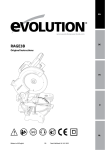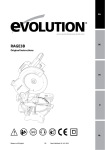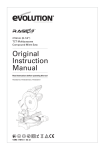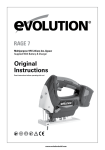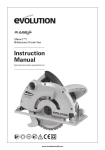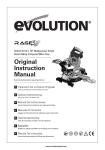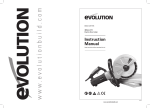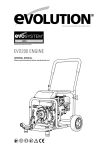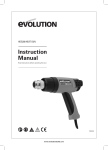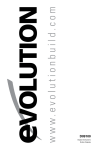Download Evolution Rage3B2102 Instruction manual
Transcript
® 210mm TCT Multipurpose Compound Mitre Saw Original Instructions Read instructions before operating this tool. www.evolutionbuild.com EC - DECLARATION OF CONFORMITY EC - DECLARATION OF CONFORMITY GB GB We, manufacturer and importer Evolution Power Tools Ltd. Venture One Sheffield S20 3FR Original Instructions Read instructions before operating this tool. Declare that the product TABLE OF CONTENTS EC - Declaration of Conformity 02 Important Information 03 12 Month Limited Warranty 03 General Safety Rules 03 Safety Instructions for all Saws 05 Labels & Symbols 07 Additional Specific Safety Rules 07 Specification08 Machine Overview Part numbers: RAGE3B2102, RAGE3B2102EU Evolution: RAGE3B Multi Purpose Compound Mitre Saw Complies with the essential requirements of the following European Directives: 2006/42/EC – Machine Directive 2006/95/EC – Low Voltage Directive 2004/108/EC – EMC Directive 2002/95/EC – Restriction of the use of Certain Hazardous Substances in Electrical and Electric equipment. The following standards have been applied: 09 Maintenance13 EN 61029-1:2009 EN 61029-2-9:2002 EN 55014-1:2000 +A1 +A2 EN 55014-2:1997+A1 EN 61000-3-2:2006 EN 61000-3-3:1995+A1+A2 Environmental Protection 14 Authorised by Service Parts Diagram 15 Assembly10 Operation11 Mr Matthew J Gavins Managing Director 1st May 2011 All documentation is held on file at the above address and is available, on request for review. 2 www.evolutionbuild.com IMPORTANT IMPORTANT GB Please read these operating and safety instructions carefully and completely. For your own safety, before using this equipment check that the voltage is correct and that all handles and parts are firmly secured. If you are uncertain about any aspect of using this equipment, please contact our Technical Helpline. Helpline. Technical Helpline UK Technical Helpline USA 0870 609 2297 1-866-EVO-TOOL EVOLUTION 210mm RAGE 3B Multipurpose Compound Mitre Saw Congratulations on your purchase of an Evolution Power Tool’s 210mm Multi Purpose Compound Mitre Saw. Please complete your product registration on line to validate your machine’s warranty period and ensure prompt service if needed. We sincerely thank you for selecting a product from Evolution Power Tools. 12 LIMITED WARRANTY 12 MONTH MONTH LIMITED WARRANY GB Evolution Power Tools reserves the right to make improvements and modifications to design without prior notice. Evolution Power Tools will, within twelve (12) months from the original date of purchase, repair or replace any goods found to be defective in materials or workmanship. This warranty is void if the tool being returned has been used to cut materials beyond the recommendations in the Instruction Manual or if the saw has been damaged by accident, neglect, or improper service. This warranty does not apply to machines and / or components which have been altered, changed, or modified in any way, or subjected to use beyond recommended capacities and specifications. Electrical components are subject to respective manufacturers’ warranties. All goods returned defective shall be returned prepaid freight to Evolution Power Tools. Evolution Power Tools reserves the right to optionally repair or replace it with the same or equivalent item. There is no warranty – written or verbal – for saw blades. In no event shall Evolution Power Tools be liable for loss or damage resulting directly or indirectly from the use of our merchandise or from any other cause. Evolution Power Tools is not liable for any costs incurred on such goods or consequential damages. No officer, employee or agent of Evolution Power Tools is authorised to make oral representations of fitness or to waive any of the foregoing terms of sale and none shall be binding on Evolution Power Tools. Questions relating to this limited warranty should be directed to the company’s head office, or call the appropriate Helpline number. IMPORTANT SAFETY INSTRUCTIONS To reduce the risk of electric shock, this equipment is fitted with an approved cord and plug for its intended country of use. Do not change the cord or plug in any way. GENERAL SAFETY INSTRUCTIONS GENERAL SAFETY RULES GB WARNING: When using electric tools, basic safety precautions should always be followed to reduce the risk of fire, electric shock and personal injury. Please read all of these instructions before attempting to operate this machine. Save this manual for future reference. 1. Keep work area clear. Cluttered work areas invite accidents. 2. Consider work area environment. Do not expose tools to rain. Do not use tools in damp or wet locations. Keep work area well lit. Never use tools near flammable liquids or gases. 3. Protect yourself against electric shock. Avoid body contact with earthed or grounded surfaces. 4. Keep other people away. Do not let others, especially children, come close to the work, and touch the tool or the extension lead. Keep them away from the work area. www.evolutionbuild.com 3 5. Store idle tools. When not in use, tools should be stored in a dry locked-up place, out of children’s reach. 6. Never force the tools. Your tools will be more efficient and safer when used at the rate for which they were intended. 7. Use the right tool. Do not force small tools to do the job of a heavy duty tool. Do not use tools for purposes not intended; for example do not use circular saws to cut tree limbs or logs. 8. Dress properly. Do not wear loose clothing or jewellery which may get caught in moving parts. Non-skid footwear is recommended when working outdoors. If you have long hair, tie it back and wear protective hair covering. 9. Use protective equipment. Use safety glasses. Use face or dust mask if cutting operations create dust. 10. Connect dust extraction equipment. If the machines have a connection for dust extraction equipment, ensure these are connected and properly used. 11. Do not damage the cable. Never pull the power cable to disconnect the machine. Keep the cable away from heat, oil and sharp edges. 12. Secure workpiece. Where possible, use clamps or a vice to hold the workpiece. It’s much safer than using your hands. 13. Don’t over reach. Keep proper footing and balance at all times. 14. Maintain tools in good working condition. Keep cutting tools sharp and clean for better performance and optimum safety. Follow instructions for lubricating and changing accessories. Inspect power cables regularly and, if damaged, have them replaced by an authorised service centre. Inspect extension cables regularly and replace immediately if damaged. Keep handles dry, clean and free from oil and grease at all times. 4 15. Disconnect tools. Disconnect tools from the power supply when not in use, before any maintenance operation and when changing accessories such as blades, bits, cutters, etc. 16. Remove adjusting keys and spanners. Get into the habit of checking that adjusting keys and spanners have been removed from the machine before turning it on. 17. Avoid unintentional starting. Ensure switch is in “off” position before plugging in the machine. 18. Use proper extension leads. When the tool is used outdoors, use only extension leads intended for outdoor use and labelled as such. 19. Stay alert. Concentrate on what you are doing, use common sense and do not operate the tool when you are tired. 20. Check that no part is damaged. Before using a tool, make sure that it is in good working order. Check the alignment and condition of moving parts, mounting and any other aspect that may affect its operation. A guard or other part that is damaged should be properly repaired or replaced by an authorised service centre unless otherwise indicated in this instruction manual. Do not use the tool if the switch does not turn on and off. 21. Warning. The use of any accessory or attachment other than one recommended in this instruction manual may present a risk of personal injury. 22. Have your tool repaired at an authorised service centre. This electric tool complies with current safety rules. Repairs should only be carried out by an authorised service centre using original spare parts. Failing this, the user could expose themselves to considerable danger. www.evolutionbuild.com HEALTH ADVICE WARNING: When drilling, sanding, sawing or grinding, dust particles will be produced. In some instances, depending on the materials you are working with, this dust can be particularly harmful to you (e.g. lead from old gloss paint).You are advised to consider the risks associated with the materials you are working with and to reduce the risk of exposure. You should: • Work in a well-ventilated area. • Work with approved safety equipment, such as dust masks that are specially designed to filter microscopic particles. GB SAFETY INSTRUCTIONS FOR ALL SAWS SAFETY INSTRUCTIONS FOR ALL SAWS a) DANGER: Keep hands away from cutting area and the blade. Keep your second hand on the auxiliary handle, or motor housing. If both hands are holding the saw, they cannot be cut by the blade. b) Do not reach underneath the workpiece. The guard cannot protect you from the blade below the workpiece. c) Adjust the cutting depth to the thickness of the workpiece. Less than a full tooth of the blade teeth should be visible below the workpiece. d) Never hold piece being cut in your hands or across your leg. Secure the workpiece to a stable platform. It is important to support the work properly to minimize body exposure, blade binding, or loss of control. e) Hold power tool by insulated gripping surfaces when performing an operation where the cutting tool may contact hidden wiring or its own cord. Contact with a “live” wire will also make exposed metal parts of the power tool “live” and shock the operator. f) When ripping always use a rip fence or straight edge guide. This improves the accuracy of cut and reduces the chance of blade binding. g) Always use blades with correct size and shape (diamond versus round) of arbor holes. Blades that do not match the mounting hardware of the saw will run eccentrically, causing loss of control. h) Never use damaged or incorrect blade washers or bolt. The blade washers and bolt were specially designed for your saw, for optimum performance and safety of operation. Further safety instructions for all saws Causes and operator prevention of kickback: Kickback is a sudden reaction to a pinched, bound or misaligned saw blade, causing an uncontrolled saw to lift up and out of the workpiece toward the operator: 1. When the blade is pinched or bound tightly by the kerf closing down, the blade stalls and the motor reaction drives the unit rapidly back toward the operator; 2. If the blade becomes twisted or misaligned in the cut, the teeth at the back edge of the blade can dig into the top surface of the workpiece causing the blade to climb out of the kerf and jump back towards the operator. Kickback is the result of saw misuse and/ or incorrect operating procedures or conditions and can be avoided by taking proper precautions as given below. a) Maintain a firm grip with both hands on the saw and position your arms to resist kickback forces. Position your body to either side of the blade, but not in line with the blade. Kickback could cause the saw to jump backwards, but kickback forces can be controlled by the operator, if proper precautions are taken. b) If the blades are binding, or when interrupting a cut for any reason, release the trigger and hold the saw motionless in the material until the blades come to a complete stop. Never attempt to remove the saw from the work or pull the saw backward while the blades are in motion or kickback may occur. Investigate and take corrective actions to eliminate the cause of blade binding. www.evolutionbuild.com 5 c) When restarting a saw in the workpiece, centre the saw blade in the kerf and check that saw teeth are not engaged into the material. If saw blade is binding, it may walk up or kickback from the workpiece as the saw is restarted. d) Support large panels to minimise the risk of blade pinching and kickback. Large panels tend to sag under their own weight. Supports must be placed under the panel on both sides, near the line of cut and near the edge of the panel. e) Blade depth and bevel adjusting locking levers must be tight and secure before making a cut. If blade adjustment shifts while cutting. it may cause binding and kickback. f) Do not use dull or damaged blades. Unsharpened or improperly set blades produce a narrow kerf causing excessive friction, blade binding and kickback. g) Use extra caution when making a “plunge cut” into existing walls or other blind areas. The protruding blade may cut objects that can cause kickback. Safety instructions for saws a) Check lower guard for proper closing before each use. Do not operate the saw if lower guard does not move freely and close instantly. Never clamp or tie the lower guard into the open position. If saw is accidentally dropped, lower guard may be bent. Raise the lower guard with the retracting handle and make sure it moves freely and does not touch the blade or any other part, in all angles and depths of cut. b) Check the operation of the lower guard spring. If the guard and the spring are not operating properly, they must be serviced before use. Lower guard may operate sluggishly due to damaged parts, gummy deposits, or a build-up of debris. c) Lower guard may be retracted manually only for special cuts such as “plunge cuts” and “compound cuts.” Raise lower guard by retracting handle and as soon as blade enters the material, the lower guard must be released. For all other sawing, the lower guard should operate automatically. 6 d) Always observe that the lower guard is covering the blade before placing saw down on bench or floor. An unprotected, coasting blade will cause the saw to walk backwards, cutting whatever is in its path. Be aware of the time it takes for the blade to stop after switch is released. SAFETY LABELS &LABELS SYMBOLS & SYMBOLS GB WARNING: Do not operate machine if warning and / or instruction labels are missing or damaged. Contact Evolution Power Tools for replacement labels. Symbol Description V Volts A Amperes Hz Hertz Min -1 Speed ~ Alternating Current n0 No Load Speed Double Insulated Wear Safety Goggles Wear Ear Protection Do Not Touch Wear Dust Protection Restriction of Hazardous Substances Directive CE certification Waste electrical and electronic equipment Only use genuine Evolution replacement saw blades. Unauthorized blades may be dangerous! Keep saw blades securely fastened. Check the blade flanges for debris before installing any new blade. Do not use dull, broken or damaged blades. Check the blade regularly for condition and wear. A damaged or worn blade should be www.evolutionbuild.com replaced immediately. Beware of ejecting chips as they may be HOT. Always make provision for the safe handling of excess material. Keep the machine base and rotary table free from dirt and other debris. To obtain an additional copy of your manual, please contact Evolution Power Tools at: UK 0870 609 2297 USA 1-866-EVO-TOOL WEBwww.evolutionpowertools.com ADDITIONAL SPECIFIC SAFETY RULES ADDITIONAL SAFETY INSTRUCTIONS GB WARNING: Be sure to read and understand all instructions. Failure to follow all instructions listed below may result in electric shock, fire and/or serious personal injury. 1. Know your power tool. Read operator’s manual carefully. Learn the applications and limitations, as well as the specific potential hazards related to this tool. 2. Always wear safety glasses or eye shields when using this mitre saw. Everyday eyeglasses have only impactresistant lenses; they are not safety glasses. 3. Always protect your lungs. Wear a face mask or dust mask if the operation is dusty. 4. Always protect your hearing. Wear hearing protection during extended periods of operation. 5. Inspect the machines power cord regularly and if damaged have it repaired or replaced. Always be aware of the cords location. 6. Always check for damaged parts. Before further use of the tool, a guard or other part that is damaged should be carefully checked to determine if it will operate properly and perform its intended function. Check for misalignment or binding of moving parts, breakage of parts, and any other condition that may affect the tool’s operation. A guard or other part that is damaged should be properly repaired or replaced at a qualified service centre. 7. Do not abuse the cord. Never use the cord to carry the tools or pull the plug from the outlet. Keep cord away from heat, oil, sharp edges or moving parts. Replace damaged cords immediately. Damaged cords increase the risk of electric shock. 8. Always make sure that your extension cord is in good condition. When using an extension cord be sure to use one that is heavy enough to carry the current that your tool will draw. An undersized cord will cause a drop in line voltage, resulting in loss of power and overheating. 9. Do not use the tool while tired or under the influence of drugs, alcohol or any medication. Following this rule will reduce the risk of electric shock, fire or serious personal injury. 10. Save these instructions. Refer to them frequently and use them to instruct others who may use this tool. If someone borrows this tool, make sure they have these instructions also. 11. When the correct blade (RAGE 3B Multipurpose TCT Blade) is fitted, this saw is recommended for cutting Mild Steel, Aluminium and Wood . 12. Do not use High Speed Steel (HSS) saw blades or blades that are damaged or deformed. 13. Replace the table insert when worn. 14. Use only saw blades recommended by the manufacturer and which are the exact bore and diameter required for this machine. 15. Connect your mitre saw to a dust collecting device (I. D.Ø32mm) when cutting wood. (O.D. 39) 16. Select saw blades in relation to the material to be cut. 17. Check the maximum depth of cut. 18. When sawing long work pieces, always use extra support to provide better support, and use clamps or other clamping devices. 19. The operator is adequately trained in the use, adjustment and maintenance of the machine. 20. Provide for adequate room lighting at your workplace or for adequate lighting of the immediate work area. 21. When fitted with a laser no exchange with a different type of laser is permissible. Repairs shall only be carried out by the laser manufacturer or an authorised agent. www.evolutionbuild.com 7 22. Refrain from removing any cut-offs or other parts of the workpiece from the cutting area whilst the machine is running and the saw head is not in the rest position. 23. Never stand on this tool. Serious injuries could occur when this tool tips over or when coming in contact with the saw blade. SPECIFICATION GB Designed to cut: Mild Steel Plate Max Thickness 6mm Mild Steel Box Section Max Wall Thickness 3mm Aluminium Wood Max section 50mm x 120mm ADDITIONAL ACCESSORIES In addition to the standard accessories supplied with this machine, other accessories are available to improve its performance, these include the following items: Technical Data Motor (230v ~ or 110v ~ 50/60 Hz) 1100W RPM No Load (min-1)4000 Recommended Maximum Duty Cycle (Minutes) 30mins Blade Dimensions Diameter Bore Diameter Thickness WARNING: The vibration emission during actual use of the power tool can differ from the declared total value depending on the ways in which the tool is used. The need to identify safety measures and to protect the operator are based on an estimation of exposure in the actual conditions of use (taking account of all parts of the operating cycle, such as the times the tool is switched off, when it is running idle, in addition to trigger time). (81/4”) 210mm (1”) 25.4mm 1.7mm 1. Clamping System – the design of this machine allows for the use of a top clamp which can be fitted either side of the blade in the sockets incorporated into the fence. 2. Diamond Blade – Convert this machine to a ‘Tile Cutter’. By replacing the standard TCT Blade with the optional Diamond Blade, this machine becomes a tile cutter – suitable for most ceramic / porcelain tiles. Additional accessories can be obtained by contacting your local dealer (or Evolution Power Tools). Maximum Cutting Capacity (Wood) At 90º mitre x 90º bevel 120mm x 50mm At 45º mitre x 45º bevel 80mm x 30mm Noise and Vibration Data Sound pressure level: 92dB(A) (K = 3dB(A)) Sound power level: 105dB(A) (K = 3dB(A)) Vibration level: 2.694 m/s2 (K = 1.5 m/s2) The declared vibration total value has been measured in accordance with a standard test method and may be used for comparing one tool with another. The declared vibration total value may also be used in a preliminary assessment of exposure. 8 www.evolutionbuild.com MACHINE OVERVIEW GB 1. SAFETY RELEASE LEVER 2. ON/OFF TRIGGER SWITCH 3. HANDLE 4. BEVEL LOCK HANDLE 5. RETRACTABLE SAFETY GUARD 6. MITRE ANGLE LOCKING SCREW 7. SAW HEAD LOCK PIN 8. TABLE TOP 9. TABLE INSERT 10. ANGLE SCALE 11. MOUNTING HOLE 12. DUST BAG 13. FENCE 14. BLADE 15. HOLD DOWN CLAMP ASSEMBLY ASSEMBLY GB Your Evolution Power Tools saw is shipped complete. Remove all contents from the box and inspect to ensure no damage was incurred during shipping, and that the items listed below are included. Item Quantity Instruction Manual 1 Allen Key (for Blade Installation) 1 Dust Collection Bag 1 Multi-Purpose TCT Blade (Fitted) 1 Hold Down Clamp 1 1 9 12 7 10 5 2 4 3 6 14 13 15 8 11 www.evolutionbuild.com 9 GETTING STARTED Caution: ALWAYS DISCONNECT THE SAW FROM POWER SOURCE BEFORE MAKING ANY ADJUSTMENTS. Fig 1 1. Mounting the Mitre Saw WARNING: To reduce the risk of injury from unexpected saw movement, place the saw in the desired location either on a workbench or other suitable machine stand. The base of the saw has four mounting holes through which suitable bolts can be placed to secure the mitre saw. If the saw is to be used in one location, permanently fasten it to the workbench using appropriate fastenings. Locking washers and nuts should be used on the underside of the workbench. 1. Tighten the mitre and bevel locks. See operating instructions. 2. To avoid injury from flying debris, position the saw so that other people or bystanders cannot stand too close (or behind) it. 3. Locate the saw on a firm, level surface where there is plenty of room for handling and properly supporting the workpiece. 4. Support the saw so the machine table is level and the saw does not rock. 5. Bolt or clamp the saw securely to its support stand or workbench. 2. Installing or removing the blade Fig 2 WARNING: Only use genuine Evolution blades which are designed for this machine. Ensure that the maximum speed of the blade is compatible with the machine. Note: It is recommended that the operator considers wearing protective gloves when handling the blade during installation or when changing the machines blade. 1. Ensure the cutting head is up. 2. Release the lower guard operating arm from the machine by removing the pivot screw. (Fig. 1) Store this screw safely for future use. 3. Press safety lock button in and rotate the lower blade guard up into the upper blade guard. (Fig. 2) 4. Press the lock button to lock the arbor. (Fig. 3) 5. Using the supplied allen key, release the arbor screw to remove the blade. (Fig. 4) Note: The arbor screw has a left hand thread. 10 www.evolutionbuild.com 6. Install the new 210 mm (8-1/4”) blade. Make sure the rotation arrow on the blade matches the clockwise rotation arrow on the upper guard. The blade teeth should always point downward at the front of the saw. 7. Install the blade washer and arbor screw. 8. Lock the arbor and use the allen key to secure the blade. 9. Tighten the arbor screw using moderate force, but do not overtighten. 10. Replace the guard operating arm using the stored screw. (Fig. 1) 11. Ensure that the allen key is removed and the arbor lock has released before operating the machine Fig 3 WARNING: Ensure the blade guard is fully functional before using the machine. Note: Spacers and spindle rings should not be used with this machine and/or blade. 3. Debris collection bag The Debris Collection Bag should be attached at the debris extraction port. 1. Slide the frame of the collection bag on to the outlet of the extraction port, ensuring that it is firmly connected. 2. To release the bag, slide the frame in the opposite direction. Note: To ensure optimal dust collection, empty the dust bag when it becomes approximately 2/3 full. Fig 4 WARNING: Before cutting metal materials, the collection bag should be removed and replaced with a blanking plug. Reinstate the dust bag when cutting wood. OPERATING INSTRUCTIONS OPERATION GB Disconnect the Mitre Saw and inspect your Saw before each use. Note: It is important that the operator is adequately trained in the use, adjustment and operation of the machine and has read this instruction and safety manual before commencing operations. WARNING: To reduce the risk of injury, always unplug the saw before changing or adjusting any of the machines parts. Compare the direction of rotation arrow on the guard to direction arrow on the blade. The blade teeth should always point downward at the front of the saw. Check the tightness of the arbor screw. www.evolutionbuild.com 11 1. Releasing the saw head a) Gently press down on the cutting handle. b) Pull out the head stop latching knob and allow the head to rise to its upper position. Note: We recommend that when the machine is not in use the cutting head is locked in its down position, and the latching knob fully engaged in its socket. 2. Preparing to make a cut a) Avoid awkward operations and hand positions where a sudden slip could cause fingers or hands to move into the blade. b) Cut only one workpiece at a time. c) Clear everything except the workpiece and related support devices away from the blade before turning the mitre saw on. d) Secure workpiece using clamps to hold the workpiece securely. 3. Body and Hand position a) Never place hands within the ‘no hands zone’ (at least 150mm away from the blade). Pictograms on the machines table are provided as an aid to safe working practices. Keep hands away from the path of the blade. b) Hold the workpiece firmly to the fence to prevent any movement. Use a clamp if necessary but check that it is positioned so that it does not foul the blade. c) Before attempting a cut, make a ‘dry run’ with the power off so that you can see the path of the blade. d) After completing a cut keep your hands in position until the trigger has been released and the blade has come to a complete halt. 4. Cutting The saw handle is gently pushed down to cut through a workpiece. a) Place the workpiece on the table and against the fence in the desired position. Secure with clamps if necessary. b) Grasp the saw handle. c) Turn on the saw using the trigger switch and allow the blade to reach full operating speed. d) Press the lower guard release lever to release the saw head. 12 e) Gently push the saw head down and cut through the workpiece. f) After the cut is completed, turn off the saw using the trigger switch, and allow the blade to come to a complete halt. 5. Mitre Cutting Any angle from 450 left to 450 right is available, and a protractor scale can be found on the RH side of the machine table. a) Loosen the mitre angle locking screw. This is situated on the LH side of the machine table just behind the table fence. Note: The mitre angle locking screw has an adjustable sprung loaded lever. This enables the lever to be repositioned on the locking screw. Repositioning may be necessary to avoid fouling other parts of the machine when a mitre angle is set. To reposition, lift up the lever and turn to a convenient angle. Release the lever. b) Turn the table to the desired angle as indicated on the mitre protractor scale. c) Lock the table into position using the locking screw d) Start the saw and allow to reach full operating speed before making the cut. 6. Bevel Cutting The saw head can be set at any angle up to a 450 to the LH side only. The bevel angle locking hand-wheel is found at the rear of the machine. a) Loosen the bevel lock hand-wheel. b) Tilt the saw head to the desired angle. A protractor guide is provided behind the handwheel to aid setting. c) Ensure the hand-wheel is tightened securely when the required angle has been achieved. d) Stand to the left hand side of the handle to make the cut. www.evolutionbuild.com 7. Compound Cutting A compound cut is a combination of a mitre and bevel cut. a) Select the required mitre angle as previously described. b) Select the required bevel angle as previously described. c) Ensure the tightness of all adjustment/locking screws before making a cut. 8. Cutting Bowed Material Before cutting any workpiece, check to see if it is bowed. If it is bowed the workpiece must be positioned and cut as shown. (Fig. 5) Do not position the workpiece incorrectly or cut the workpiece without the support of the fence. 9. Clearing Jammed Material 1. Turn mitre saw “OFF” by releasing the trigger switch. 2. Wait for all moving parts to stop. 3. Unplug the mitre saw from the mains supply. 4. Remove jammed material from the unit. Fig 5 10. Transporting a) Ensure that the head of the machine is locked in the down position. b) Ensure that the machines power cord is safely stored. c) Use the carrying handle on the top of the saw head to lift and transport the machine. MAINTENANCE MAINTENANCE GB Note: Any maintenance must be carried out with the machine switched off and disconnected from the mains power supply. All motor bearings in this machine are lubricated for life. No further lubrication is required. Apply light machine oil to the machines pivot points and lower blade operating arm. Avoid excessive oil, to which sawdust will cling. Periodically, sawdust may accumulate under the work table and the base. Use a vacuum cleaner to remove this sawdust. Use a clean, slightly damp cloth to clean the plastic parts of the machine. Do not use solvents or similar products which could damage the plastic parts. WARNING: Do not attempt to clean by inserting pointed objects through openings in the machines casings etc. The machines air vents should be cleaned using compressed dry air. www.evolutionbuild.com 13 ENVIRONMENTAL PROTECTION ENVIRONMENTAL PROTECTION GB Waste electrical products should not be disposed of with household waste. Please recycle where facilities exist. Check with your Local Authority or retailer for recycling advice. 14 www.evolutionbuild.com SERVICE PARTS DIAGRAM GB www.evolutionbuild.com 15 w w w. e v o l u t i o n b u i l d . c o m E11103 ®
















